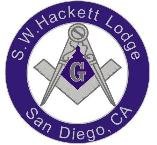
~ The Square ~

This is one of the most important and significant Symbols in Freemasonry. As such, it is proper that its true form should be preserved. French Freemasons have almost universally given it with one leg longer than the other, thus making it a carpenter's square American Freemasons, following the incorrect delineations of Brother Jeremy L. Cross, have, while generally preserving the equality of length in the legs, unnecessarily marked its surface with inches; thus making it an instrument for measuring length and breadth which it is not. It is simply the trying square of a stone-mason, and has a plain surface; the sides or legs embracing an angle of ninety degrees, and is intended only to test the accuracy of the sides of a stone, and to see that its edges subtend the same angle.
In Freemasonry, the square is a symbol of morality. This is its general signification, and is applied in various ways:
It presents itself to the neophyte as one of the Three Great Lights.
To the Fellow Craft as one of his Working-tools.
To the Master Mason as the official emblem of the Master of the Lodge.
Everywhere, however, it inculcates the same lesson of morality, of truthfulness, of honesty. So universally accepted is this symbolism that it has gone outside of the Order, and has been found in colloquial language communicating the same idea. Square, says Halliwell, Dictionary of Archaic and Provincial Words, means honest, equitable, as in "square dealing." To play upon the square is proverbial for to play honestly. In this sense the word is found in the old writers.
As a Masonic symbol, it is of very ancient date, and was familiar to the Operative Masons. In the year 1830, the architect, in rebuilding a very ancient bridge called Baal Bridge, near Limerick, in Ireland, found under the foundation-stone an old brass square, much eaten away, containing on its two surfaces the following inscription, the U being read as V: I. WILL. STRIUE. TO. LIUE.-WITH. LOUE. & CARE.- UPON. THE. LEUEL.-BY. THE. SQUARE., and the date 1517. The modern Speculative Freemason will recognize the idea of living on the level fled by the square This discovery proves, if proof were necessary, that the familiar idea was borrowed from our Operative Brethren of former days.
The square, as a symbol in Speculative Freemasonry, has therefore presented itself from the very beginning of the revival period. In the very earliest catechism of the eighteenth century, of the date of 1725, we find the answer to the question, "How many make a Lodge?" is "God and the Square, with five or seven right or perfect Masons." God and the Square, religion and morality, must be present in every Lodge as governing principles.
Signs at that early period were to be made by squares and the Furniture of the Lodge was declared to be the Bible, Compasses, and Square.
In the public lecture of Brother Herbert A. Giles, Worshipful Master of Ionic Lodge, No. 1781 at Amoy, delivered in 1880 and entitled Freemasonry in China, says:
From time immemorial we find the Square and Compasses used by Chinese Writers to symbolize precisely the same phases of moral conduct as in our system of Freemasonry. The earliest passage known to one which bears upon the subject is to be found in the Book of history embracing the period reaching from the twenty-fourth to the seventh century before Christ. There in an account of a military expedition we read:
"Ye officers of government, apply the Compasses!"
In another part of the same venerable record a Magistrate is spoken of as:
" A man of the level, or the level man"
The public discourses of Confucius provide us with several Masonic allusions of a more or less definite character. For instance. when recounting his own degrees of moral progress in life, the Master tells us that only at seventy-five spears of age could he venture to follow the inclinations of his heart without fear of " transgressing the limits of the Square." this would be 481 B.C. belt it is in the works of his great follower, Mencius, who flourished nearly two hundred years later, that we meet with a fuller and more impressive Masonic phraseology. In one chapter we are taught that just as the most skilled artificers are unable, without the aid of the Square and Compasses to produce perfect rectangles or perfect circles, so must all men apply these tools figuratively to their lives, and the level and the marking-line besides, if they would walk in the straight and even paths of wisdom and keep themselves within the bonds of honor and virtue. In Book iv we read:
"The Compasses and Square are the embodiment of the rectangular and the round, just as the prophets of old were the embodiment of the due relationship between man and man" In Book vi we find these words:
The Master Mason, in teaching his apprentices makes use of the Compasses and the Square Ye who are engaged in the pursuit of wisdom must also make use of the Compasses and the Square. In the Great Learning, admitted on all sides to date from between 300 to 400 years before Christ, in Chapter 10, we read that a man should abstain from doing unto others what he would not they should do unto him, ' this," adds the writer, is called the principle of acting on the Square. " In all rites and in all languages where Freemasonry has penetrated, the square has preserved its primitive Signification as a symbol of morality.